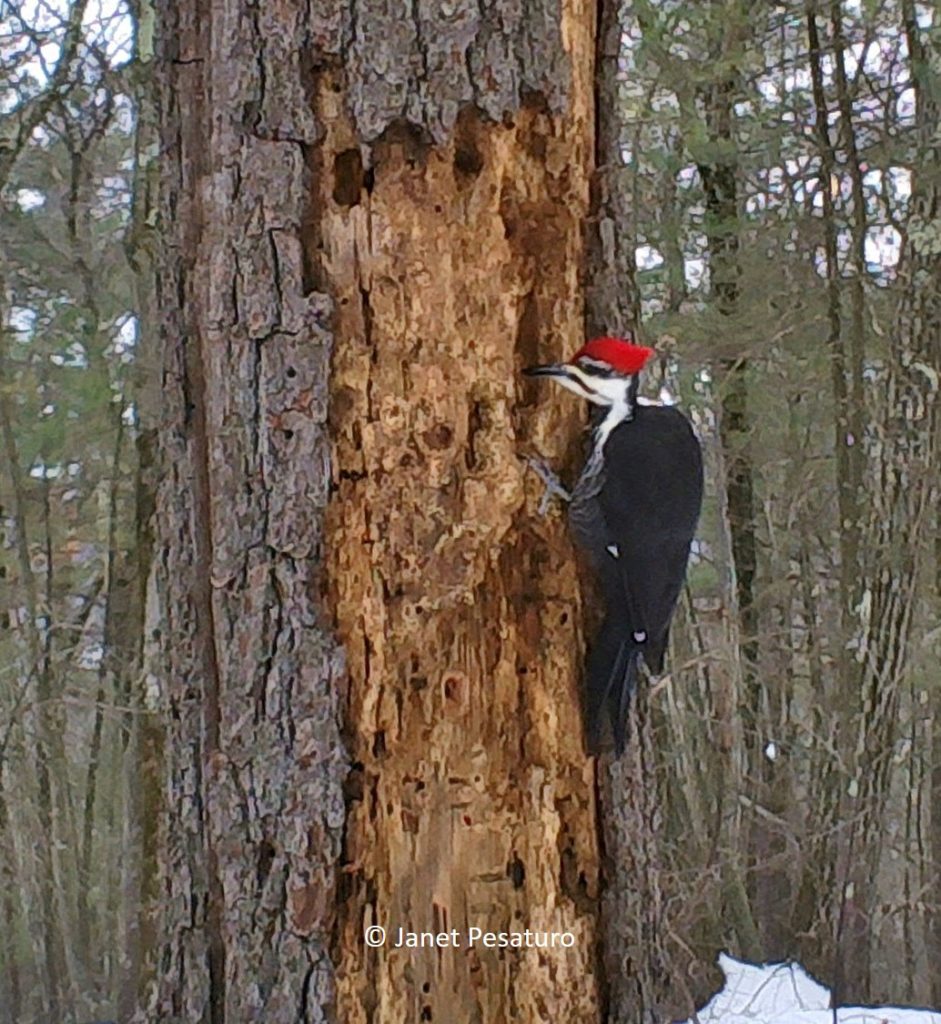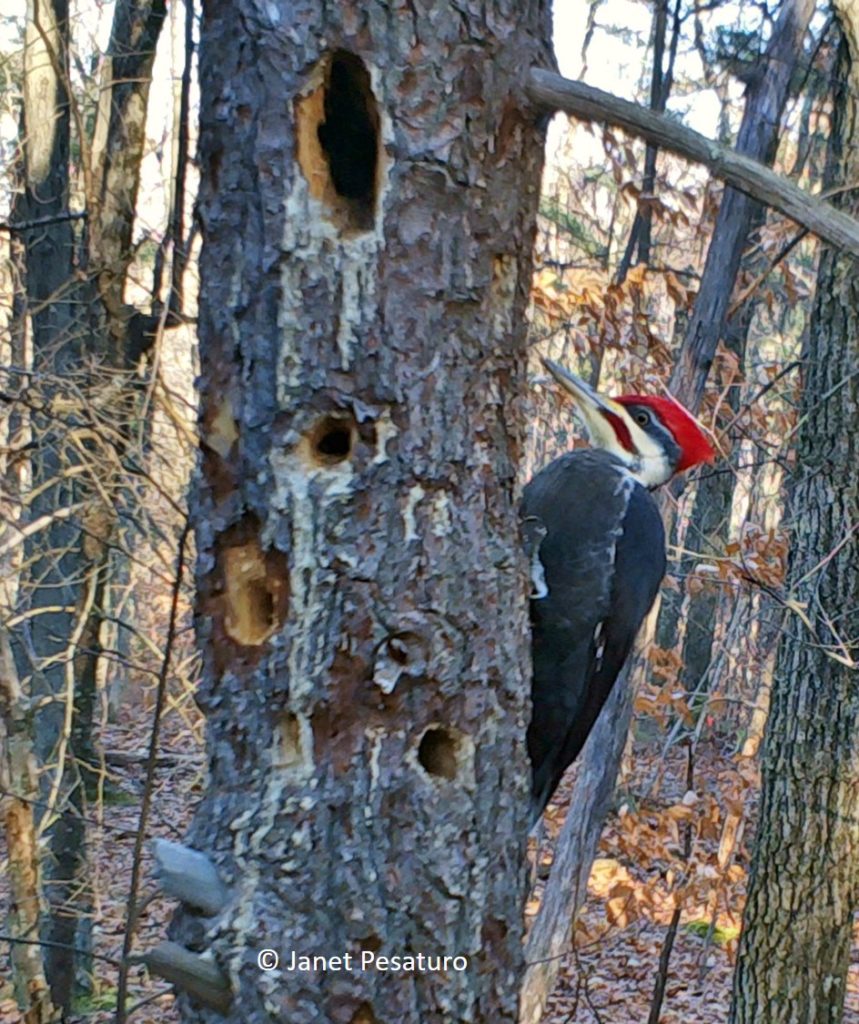Camera Trapping Pileated Woodpeckers

A pileated woodpecker visiting an old excavation in winter. (Browning Strike Force HD Pro trail camera)
Winter is a good time for camera trapping pileated woodpeckers, because the birds usually return to feed at carpenter ant infested trees discovered the previous summer. It’s thought that the birds find ant colonies by sound, but they can do this only when the ants are active, which is during the warmer months. In winter, the ants are in diapause, so the birds can’t hear them and therefore rely on colonies they found a few months before.
To capture this bird, aim your camera at the freshest pileated woodpecker foraging sign you can find, and give it at least a few weeks. The birds may feed at any level, from exposed roots to high branches. Foraging sign close to ground level is common, so you won’t have to climb a tree to set the camera at the proper height. Pileated woodpeckers also tend to excavate new holes right near existing holes, so targeting an existing hole, or cluster of holes, should bring success.
Because pileated woodpeckers mate for life, a mated pair remain in contact all winter, which means there’s a good chance both a male and a female will appear at the same feeding site even in winter, though not necessarily at the same time.
You can certainly try camera trapping this species at feeding sites in summer, but I’m guessing their foraging behavior is somewhat less predictable during the warmer months, when they spend more time searching their home range, listening for new ant colonies.
This past winter, I targeted 7 trees with fresh sign in Massachusetts, and after a couple of months, 3 of the 7 cameras had captured this large, charismatic bird. That success rate speaks to the predictability of their behavior in winter, when you consider the fact that a pair’s home range in the Northeast is probably well over a hundred acres of forest. Of the many, many trees within their home range, they spend much of their foraging time at a select few. One camera caught both a male and a female – probably a mated pair.

A male pileated woodpecker camera trapped in winter. The female was also capture at this tree. (Exodus Lift II trail camera)

I’m enjoying your blogs, so informative! Sharing the Coyote piece with my hubby, who SWEARS he saw a wolf in our backyard. It’ll be fun to see if he still stands by that claim after viewing the video of the E. Coyote rendezvous site! Today I was thrilled to see the Pileated return to our neighborhood, as they do every year. Unfortunately, they seem to only ‘travel thru’, not nest. I will try to look more closely for their feeding holes, tho. I’d love nothing more than just ONE pic… OH, a question: Is there a difference between Coywolf & Eastern Coyote?
Hi Linda! Coywolf doesn’t really have a specific definition. For the most part, it’s a word used by lay people to describe a coyote that they think looks larger or more wolf like than what they expect.
Some biologists want to rename the eastern coyote and call it the coywolf, but that hasn’t yet gained wide acceptance; probably for good reason. Genetic studies show that, other than wolves in AK and northwestern Canada, and coyotes in the far western US, all wolves and coyotes are hybrids to various degrees. Therefore, most wolves and coyotes could be considered coywolves.
We could call them all coywolves, but that would blur an important distinction, which is how they live and hunt. Those hybrids which have mostly coyote DNA, such as our eastern coyotes, usually live more like coyotes – hunting mostly small prey and living singly or in small packs. Those hybrids which have mostly wolf DNA, such as Wisconsin wolves, usually live like wolves – hunting mostly large prey and living in larger packs.
LOVED the pileated woodpecker report. The point about winter vs. summer foraging behavior is great. Living in the city, I see them rarely enough that it’s pretty exciting when they appear. Thanks for posting!
My pleasure, John. I had never seen one till we moved well away from the city. Now I see them once in a while, and it’s still exciting every time.
Next step finding a pileated nest cavity. I’d love to see little guy pileateds.
Also liked the side conversation about coy wolves.
Thanks
Ah, yes, targeting a nest cavity would be the next step. I’ve thought about it — it would require putting one of those climbing sticks or ladders, like hunters use to put up tree stands, to get the camera into a neighboring tree. Someday…
Hi Janet,
Thank you for this post. I didn’t even think of the ants not moving in winter due to diapause. Thanks for pointing that out.
I was wondering if you have noticed more winter feeding towards the base of the trees rather than higher up? I have heard that this happens because the ants migrate to lower areas on the tree as the ground is warmer than the ambient air temperatures higher up.
I guess when I look around I think I am seeing this, but am also curious about another opinion.
Hi Byron, that is a great question and one I never thought about. I really don’t know if they forage closer to the base of the tree in winter and never thought to look up high to see how much activity is going up there in winter vs down low, but what you say makes sense. It sure would explain why it was relatively easy for me to camera trap them down low in winter. My success rate was higher and it took less time than I expected. Thanks for asking that. I will keep it in mind as I walk the winter woods.